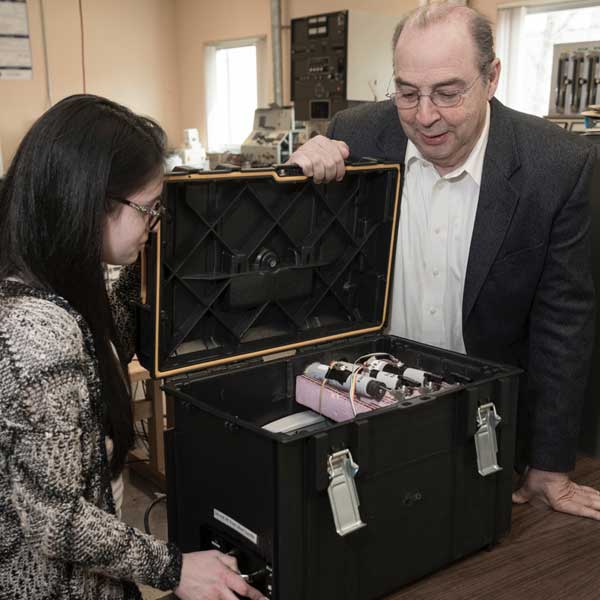It’s the size of a toolbox, and just as sturdy. It’s lightweight and even has a handle so it can be carried—quickly, if necessary—to different locations.
And if all goes as planned, the “Digital Dog Nose,” created by Otto Gregory, professor of chemical engineering, could soon be placed at subway stations, train stations, airports, and ports to detect bombs.
“We’ve made great progress on the project, and now we’re ready to get the word out,” says Gregory, whose work is funded by the U.S. Department of Homeland Security. “We’ve turned a corner with these latest developments. I’m very excited about the future of the product. We’re trying to make life safer for people throughout the world.”
Two years ago, Gregory and his students created a sensor to detect explosives commonly used by terrorists. One of the explosives is triacetone triperoxide, or TATP, which was used by terrorists in the Paris and Brussels attacks several years ago. Terrorists use TATP because it is easy to make with chemicals that can be purchased at pharmacies and hardware stores without attracting attention. Only small amounts are needed to cause large explosions.
The prototype was able to detect explosives at very low concentrations, as low as one molecule of an explosive in a billion molecules of air.
Gregory’s research goal is to find a way to detect the explosives’ vapors before the bomb detonates, launching quick evacuations and saving lives. The device is also significant because it works continuously—unlike bomb-sniffing dogs that can get tired.
The sensor Gregory created two years ago works by detecting the decomposition of nearby explosive molecules, triggering an alarm in the device. Back then, the sensor was in its early stages, mostly used for experiments in Gregory’s “Sensors and Surface Technology” laboratory on campus.
Over the last 15 months, Gregory and his students have been working intensely on the project and completed a prototype in the summer. The team tested the prototype at the Naval Research Laboratory in Washington, D.C., in July, and in August at Rapiscan Systems in Andover, Mass., one of the top detection system manufacturers in the world.
“The testing exceeded our expectations,” says Andrew Rossi, who is pursuing his master’s degree in chemical engineering. “Both groups were impressed with our results. The prototype works—and works well.”
During the field trials, the prototype sucked in air contaminated with explosive molecules. Once the molecules hit the sensor, they broke apart and released heat, which, in turn, set off the sensor’s alarm.
The prototype was able to detect explosives at very low concentrations, as low as one molecule of an explosive in a billion molecules of air. “That’s amazing to us,” says Rossi. “The lower we can go, the less likelihood terrorists are going to get by security.”
The next step is to make the prototype as small as a cell phone. The team is also reaching out to partners to market the product and to federal agencies involved with national security.

